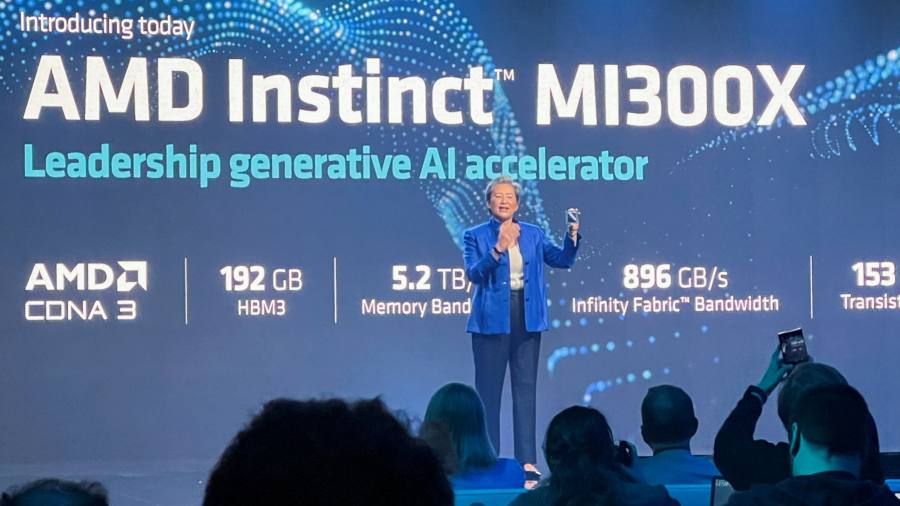Nvidia’s rivals struggle to gain ground in generative AI chip war
In the three weeks since Nvidia shocked the tech world with its forecast of an unprecedented leap in sales, Wall Street has been on the hunt for other chip companies that could benefit from the latest AI boom.
But as the search has gone on, the gulf that has opened up between Nvidia and the rest of the chip industry has only grown wider.
In one of the most anticipated attempts to catch up with Nvidia, rival AMD showed off a new AI chip this week named the MI300X. The chip includes a GPU — a product originally designed for video gaming that lies at the heart of Nvidia’s success — as well as a more general-purpose CPU and built-in memory to supply data to both processors.
The design reflects attempts by chipmakers to bundle different technologies in the search for the most efficient way to process the big volumes of data needed to train and apply the large models used in generative AI.
AMD claimed impressive performance for its new chip, which it said would top Nvidia’s flagship H100 on several measures. But it was unable to point to any potential customers who were considering the chip and only highlighted the product’s ability to handle AI inferencing — applying pre-trained AI models — rather than the more demanding job of training, which has been behind Nvidia’s surging sales. It also said it will not start ramping up production of the new chip until the final quarter of this year.
By the time AMD’s new chip becomes generally available in the first half of next year, Nvidia’s H100 will have been in the market for 18 months, giving it a huge lead, said Stacy Rasgon, an analyst at Bernstein. AMD is “way behind. They might get the dregs [of the AI market] — though maybe even that’s enough” to justify Wall Street’s recent enthusiasm for the company’s shares, he said.
“Nvidia is free and clear in this round” of the chip wars that have broken out around AI, added Patrick Moorhead, an analyst at Moor Insights & Strategy.
Wall Street has singled out a number of chips companies that could get a boost from generative AI. The combined stock market value of AMD, Broadcom and Marvell jumped by $99bn, or 20 per cent, in the two days after Nvidia’s stunning sales forecast last month. But their AI-related sales are not expected to come from the market dominated by Nvidia.
Broadcom, for instance, stands to benefit from rising demand for its data communications products, as well as its work with Google designing an in-house data centre chip, known as a TPU. Earlier this month, Broadcom predicted that AI-related business would account for about a quarter of its revenue in 2024, up from only 10 per cent last year.
However, the processors used to train and apply large AI models are getting the biggest surge in demand and generating the most stock market enthusiasm. As AMD’s new chip underwhelmed Wall Street, Nvidia’s stock market value rose back above $1tn, a level it first reached two weeks ago.
“There’s no question that AI will be the key driver of silicon consumption for the foreseeable future” with data centres the main focus of the investment, said AMD chief executive Lisa Su. She predicted that the market for AI accelerators — the GPUs and other specialised chips designed to speed up the data-intensive processing needed to train or run — would soar from $30bn this year to more than $150bn in 2027.
As they struggle to compete with Nvidia in the most advanced AI chips, companies such as AMD and Intel are counting on an evolution in the generative AI market to lift demand for other types of processors. Large-scale models such as OpenAI’s GPT-4 have dominated the early stages of the technology, but a recent explosion in the use of smaller and more specialised models could lead to higher sales of less powerful chips, they claim.
Many customers looking to train models with their corporate data will also want to keep their information close to home rather than risk handing it to the companies that provide large AI models, said Kavitha Prasad, a vice-president at Intel. Along with all the computing work that goes into preparing data to feed into the training, that will create plenty of work for the CPUs and AI accelerators made by Intel, she said.
However, the rapidly changing demands on data centres caused by the surge in services such as ChatGPT has left chipmakers struggling to anticipate how their markets will develop. Sales of CPUs could even fall in the coming years as data centre customers plough their spending into AI accelerators, said Rasgon.
Rivals hoping to take a bite out of Nvidia’s surging AI business face an equally big challenge when it comes to software. The widespread use of Nvidia’s chips in AI and other applications owes much to the ease with which its GPUs, originally designed for video gaming, can be programmed for other tasks using its Cuda software.
In an attempt to draw more developers to its AI chips, AMD this week highlighted its efforts to work with PyTorch, a widely used AI framework. Yet it still has a long way to go to match the many software libraries and applications that have already been developed for Cuda, said Rasgon. “It will be a decade” before rivals are able to match Nvidia’s software — a period in which Nvidia will still be moving fast to increase its lead, he said.
“No one wants an industry where there’s one dominant player,” said Moorhead. But for now, the booming market for chips able to handle generative AI belongs to Nvidia.
Source: Financial Times


